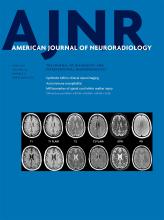Index by author
Da Ros, V.
- FELLOWS' JOURNAL CLUBNeurointerventionYou have accessLarge Basilar Apex Aneurysms Treated with Flow-Diverter StentsV. Da Ros, J. Caroff, A. Rouchaud, C. Mihalea, L. Ikka, J. Moret and L. SpelleAmerican Journal of Neuroradiology June 2017, 38 (6) 1156-1162; DOI: https://doi.org/10.3174/ajnr.A5167
The authors report their experience treating basilar apex aneurysms with flow-diverter stents and evaluate their efficacy and safety profile in this specific condition. Of the 175 aneurysms treated with flow-diverter stents at their institution, 5 patients received flow-diverter stents for basilar apex aneurysms. The mean follow-up after stent deployment was 21 months. They conclude that flow diversion is a feasible technique with an efficacy demonstrated at a midterm follow-up, especially in the case of basilar apex aneurysm recurrences after previous endovascular treatments.
Delano, M.C.
- EDITOR'S CHOICEADULT BRAINOpen AccessSynthetic MRI for Clinical Neuroimaging: Results of the Magnetic Resonance Image Compilation (MAGiC) Prospective, Multicenter, Multireader TrialL.N. Tanenbaum, A.J. Tsiouris, A.N. Johnson, T.P. Naidich, M.C. DeLano, E.R. Melhem, P. Quarterman, S.X. Parameswaran, A. Shankaranarayanan, M. Goyen and A.S. FieldAmerican Journal of Neuroradiology June 2017, 38 (6) 1103-1110; DOI: https://doi.org/10.3174/ajnr.A5227
The authors performed a prospective multireader, multicasenoninferiority trial of 1526 images read by 7 blinded neuroradiologists with prospectively acquired synthetic and conventional brain MR imaging case-control pairs from 109 subjects with neuroimaging indications. Each case included conventional T1- and T2-weighted, T1 and T2 FLAIR, and STIR and/or proton density and synthetic reconstructions from multiple-dynamic multiple-echo imaging. Images were randomized and independently assessed. Overall synthetic MR imaging quality was similar to that of conventional proton-density, STIR, and T1- and T2-weighted contrast views across neurologic conditions. Artifacts were more common in synthetic T2 FLAIR, but were readily recognizable and did not mimic pathology.
De Leener, B.
- FELLOWS' JOURNAL CLUBSpine Imaging and Spine Image-Guided InterventionsOpen AccessClinically Feasible Microstructural MRI to Quantify Cervical Spinal Cord Tissue Injury Using DTI, MT, and T2*-Weighted Imaging: Assessment of Normative Data and ReliabilityA.R. Martin, B. De Leener, J. Cohen-Adad, D.W. Cadotte, S. Kalsi-Ryan, S.F. Lange, L. Tetreault, A. Nouri, A. Crawley, D.J. Mikulis, H. Ginsberg and M.G. FehlingsAmerican Journal of Neuroradiology June 2017, 38 (6) 1257-1265; DOI: https://doi.org/10.3174/ajnr.A5163
Forty healthy subjects underwent T2WI, DTI, magnetization transfer, and T2*WI at 3T in <35 minutes using standard hardware and pulse sequences. Cross-sectional area, fractional anisotropy, magnetization transfer ratio, and T2*WI WM/GM signal intensity ratio were calculated. Reliable multiparametric assessment of spinal cord microstructure is possible by using clinically suitable methods. These results establish normalization procedures and pave the way for clinical studies.
- Spine Imaging and Spine Image-Guided InterventionsOpen AccessA Novel MRI Biomarker of Spinal Cord White Matter Injury: T2*-Weighted White Matter to Gray Matter Signal Intensity RatioA.R. Martin, B. De Leener, J. Cohen-Adad, D.W. Cadotte, S. Kalsi-Ryan, S.F. Lange, L. Tetreault, A. Nouri, A. Crawley, D.J. Mikulis, H. Ginsberg and M.G. FehlingsAmerican Journal of Neuroradiology June 2017, 38 (6) 1266-1273; DOI: https://doi.org/10.3174/ajnr.A5162
Doerfler, A.
- NeurointerventionYou have access4D DSA for Dynamic Visualization of Cerebral Vasculature: A Single-Center Experience in 26 CasesS. Lang, P. Gölitz, T. Struffert, J. Rösch, K. Rössler, M. Kowarschik, C. Strother and A. DoerflerAmerican Journal of Neuroradiology June 2017, 38 (6) 1169-1176; DOI: https://doi.org/10.3174/ajnr.A5161
Donovan, A.L.
- Spine Imaging and Spine Image-Guided InterventionsYou have accessEnhancing the Radiologist-Patient Relationship through Improved Communication: A Quantitative Readability Analysis in Spine RadiologyD.R. Hansberry, A.L. Donovan, A.V. Prabhu, N. Agarwal, M. Cox and A.E. FlandersAmerican Journal of Neuroradiology June 2017, 38 (6) 1252-1256; DOI: https://doi.org/10.3174/ajnr.A5151
Du, J.
- Head and Neck ImagingOpen AccessMR Imaging Grading System for Skull Base ChordomaK. Tian, L. Wang, J. Ma, K. Wang, D. Li, J. Du, G. Jia, Z. Wu and J. ZhangAmerican Journal of Neuroradiology June 2017, 38 (6) 1206-1211; DOI: https://doi.org/10.3174/ajnr.A5152
Dufort, P.
- FELLOWS' JOURNAL CLUBADULT BRAINYou have accessDifferentiation of Enhancing Glioma and Primary Central Nervous System Lymphoma by Texture-Based Machine LearningP. Alcaide-Leon, P. Dufort, A.F. Geraldo, L. Alshafai, P.J. Maralani, J. Spears and A. BharathaAmerican Journal of Neuroradiology June 2017, 38 (6) 1145-1150; DOI: https://doi.org/10.3174/ajnr.A5173
The authors evaluated the diagnostic performance of a machine-learning algorithm by using texture analysis of contrast-enhanced T1-weighted images for differentiation of primary central nervous system lymphoma (n=35) and enhancing glioma (n=71). The mean areas under the receiver operating characteristic curve were 0.877 for the support vector machine classifier; 0.878 for reader 1; 0.899 for reader 2; and 0.845 for reader 3. They conclude that support vector machine classification based on textural features of contrast-enhanced T1WI is noninferior to expert human evaluation in the differentiation of primary central nervous system lymphoma and enhancing glioma.
Dusek, P.
- Adult BrainOpen AccessThalamic Iron Differentiates Primary-Progressive and Relapsing-Remitting Multiple SclerosisA. Burgetova, P. Dusek, M. Vaneckova, D. Horakova, C. Langkammer, J. Krasensky, L. Sobisek, P. Matras, M. Masek and Z. SeidlAmerican Journal of Neuroradiology June 2017, 38 (6) 1079-1086; DOI: https://doi.org/10.3174/ajnr.A5166








